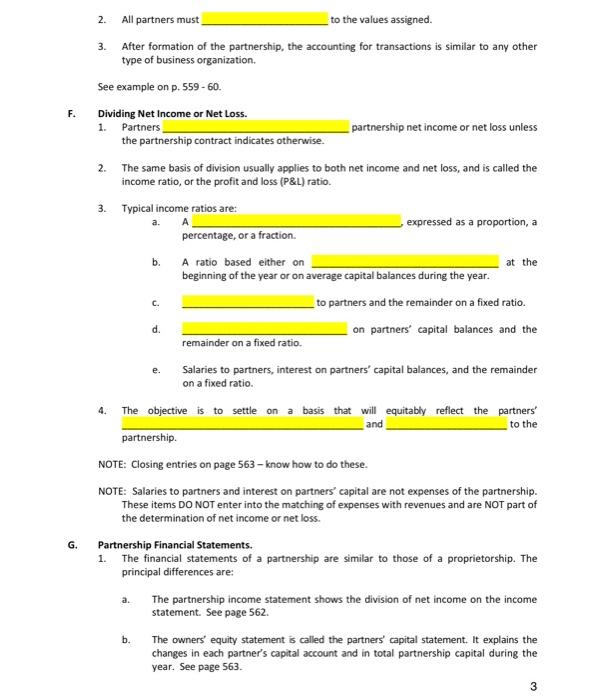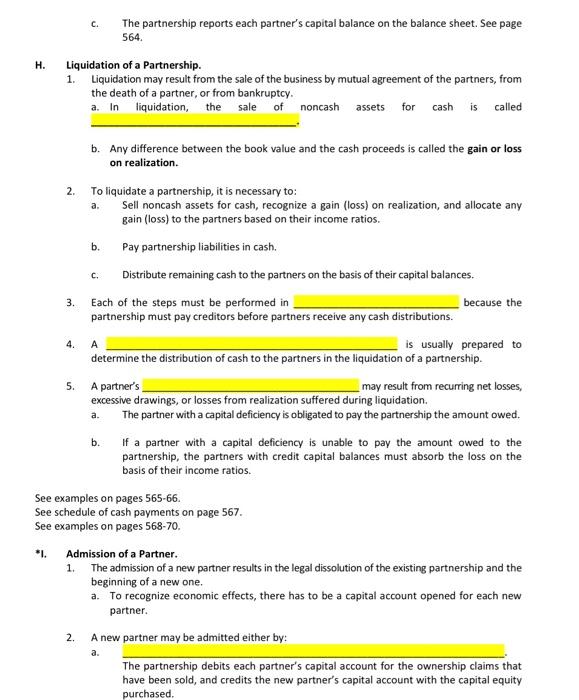Please fill in the blanks

2. All partners must to the values assigned. 3. After formation of the partnership, the accounting for transactions is similar to any other type of business organization. See example on p. 559 - 60 . F. Dividing Net Income or Net Loss. 1. Partners. , partnership net income or net loss unless the partnership contract indicates otherwise. 2. The same basis of division usually applies to both net income and net loss, and is called the income ratio, or the profit and loss (P\&L) ratio. 3. Typical income ratine are. a. A expressed as a proportion, a percentage, or a fraction. b. A ratio based either on. beginning of the year or on average capital balances during the year. c. to partners and the remainder on a fixed ratio. d. on partners' capital balances and the remainder on a fixed ratio. e. Salaries to partners, interest on partners' capital balances, and the remainder on a fixed ratio. 4. The objective is to settle on a basis that will equitably reflect the partners' and to the partnership. NOTE: Closing entries on page 563 - know how to do these. NOTE: Salaries to partners and interest on partners' capital are not expenses of the partnership. These items DO NOT enter into the matching of expenses with revenues and are NOT part of the determination of net income or net loss. G. Partnership Financial Statements. 1. The financial statements of a partnership are similar to those of a proprietorship. The principal differences are: a. The partnership income statement shows the division of net income on the income statement. See page 562 . b. The owners' equity statement is called the partners' capital statement. It explains the changes in each partner's capital account and in total partnership capital during the year. See page 563 . 3 c. The partnership reports each partner's capital balance on the balance sheet. See page 564. H. Liquidation of a Partnership. 1. Liquidation may result from the sale of the business by mutual agreement of the partners, from the death of a partner, or from bankruptcy. a. In liquidation. the sale of noncash assets for cash is called b. Any difference between the book value and the cash proceeds is called the gain or loss on realization. 2. To liquidate a partnership, it is necessary to: a. Sell noncash assets for cash, recognize a gain (loss) on realization, and allocate any gain (loss) to the partners based on their income ratios. b. Pay partnership liabilities in cash. c. Distribute remaining cash to the partners on the basis of their capital balances. 3. Each of the steps must be performed in because the partnership must pay creditors before partners receive any cash distributions. 4. A is usually prepared to determine the distribution of cash to the partners in the liquidation of a partnership. 5. A partner's. - may result from recurring net losses, excessive drawings, or losses from realization suffered during liquidation. a. The partner with a capital deficiency is obligated to pay the partnership the amount owed. b. If a partner with a capital deficiency is unable to pay the amount owed to the partnership, the partners with credit capital balances must absorb the loss on the basis of their income ratios. See examples on pages 565-66. See schedule of cash payments on page 567. See examples on pages 568-70. *1. Admission of a Partner. 1. The admission of a new partner results in the legal dissolution of the existing partnership and the beginning of a new one. a. To recognize economic effects, there has to be a capital account opened for each new partner. 2. A new partner may be admitted either by: a. The partnership debits each partner's capital account for the ownership claims that have been sold, and credits the new partner's capital account with the capital equity purchased. 2. All partners must to the values assigned. 3. After formation of the partnership, the accounting for transactions is similar to any other type of business organization. See example on p. 559 - 60 . F. Dividing Net Income or Net Loss. 1. Partners. , partnership net income or net loss unless the partnership contract indicates otherwise. 2. The same basis of division usually applies to both net income and net loss, and is called the income ratio, or the profit and loss (P\&L) ratio. 3. Typical income ratine are. a. A expressed as a proportion, a percentage, or a fraction. b. A ratio based either on. beginning of the year or on average capital balances during the year. c. to partners and the remainder on a fixed ratio. d. on partners' capital balances and the remainder on a fixed ratio. e. Salaries to partners, interest on partners' capital balances, and the remainder on a fixed ratio. 4. The objective is to settle on a basis that will equitably reflect the partners' and to the partnership. NOTE: Closing entries on page 563 - know how to do these. NOTE: Salaries to partners and interest on partners' capital are not expenses of the partnership. These items DO NOT enter into the matching of expenses with revenues and are NOT part of the determination of net income or net loss. G. Partnership Financial Statements. 1. The financial statements of a partnership are similar to those of a proprietorship. The principal differences are: a. The partnership income statement shows the division of net income on the income statement. See page 562 . b. The owners' equity statement is called the partners' capital statement. It explains the changes in each partner's capital account and in total partnership capital during the year. See page 563 . 3 2. All partners must to the values assigned. 3. After formation of the partnership, the accounting for transactions is similar to any other type of business organization. See example on p. 559 - 60 . F. Dividing Net Income or Net Loss. 1. Partners. , partnership net income or net loss unless the partnership contract indicates otherwise. 2. The same basis of division usually applies to both net income and net loss, and is called the income ratio, or the profit and loss (P\&L) ratio. 3. Typical income ratine are. a. A expressed as a proportion, a percentage, or a fraction. b. A ratio based either on. beginning of the year or on average capital balances during the year. c. to partners and the remainder on a fixed ratio. d. on partners' capital balances and the remainder on a fixed ratio. e. Salaries to partners, interest on partners' capital balances, and the remainder on a fixed ratio. 4. The objective is to settle on a basis that will equitably reflect the partners' and to the partnership. NOTE: Closing entries on page 563 - know how to do these. NOTE: Salaries to partners and interest on partners' capital are not expenses of the partnership. These items DO NOT enter into the matching of expenses with revenues and are NOT part of the determination of net income or net loss. G. Partnership Financial Statements. 1. The financial statements of a partnership are similar to those of a proprietorship. The principal differences are: a. The partnership income statement shows the division of net income on the income statement. See page 562 . b. The owners' equity statement is called the partners' capital statement. It explains the changes in each partner's capital account and in total partnership capital during the year. See page 563 . 3 c. The partnership reports each partner's capital balance on the balance sheet. See page 564. H. Liquidation of a Partnership. 1. Liquidation may result from the sale of the business by mutual agreement of the partners, from the death of a partner, or from bankruptcy. a. In liquidation. the sale of noncash assets for cash is called b. Any difference between the book value and the cash proceeds is called the gain or loss on realization. 2. To liquidate a partnership, it is necessary to: a. Sell noncash assets for cash, recognize a gain (loss) on realization, and allocate any gain (loss) to the partners based on their income ratios. b. Pay partnership liabilities in cash. c. Distribute remaining cash to the partners on the basis of their capital balances. 3. Each of the steps must be performed in because the partnership must pay creditors before partners receive any cash distributions. 4. A is usually prepared to determine the distribution of cash to the partners in the liquidation of a partnership. 5. A partner's. - may result from recurring net losses, excessive drawings, or losses from realization suffered during liquidation. a. The partner with a capital deficiency is obligated to pay the partnership the amount owed. b. If a partner with a capital deficiency is unable to pay the amount owed to the partnership, the partners with credit capital balances must absorb the loss on the basis of their income ratios. See examples on pages 565-66. See schedule of cash payments on page 567. See examples on pages 568-70. *1. Admission of a Partner. 1. The admission of a new partner results in the legal dissolution of the existing partnership and the beginning of a new one. a. To recognize economic effects, there has to be a capital account opened for each new partner. 2. A new partner may be admitted either by: a. The partnership debits each partner's capital account for the ownership claims that have been sold, and credits the new partner's capital account with the capital equity purchased. 2. All partners must to the values assigned. 3. After formation of the partnership, the accounting for transactions is similar to any other type of business organization. See example on p. 559 - 60 . F. Dividing Net Income or Net Loss. 1. Partners. , partnership net income or net loss unless the partnership contract indicates otherwise. 2. The same basis of division usually applies to both net income and net loss, and is called the income ratio, or the profit and loss (P\&L) ratio. 3. Typical income ratine are. a. A expressed as a proportion, a percentage, or a fraction. b. A ratio based either on. beginning of the year or on average capital balances during the year. c. to partners and the remainder on a fixed ratio. d. on partners' capital balances and the remainder on a fixed ratio. e. Salaries to partners, interest on partners' capital balances, and the remainder on a fixed ratio. 4. The objective is to settle on a basis that will equitably reflect the partners' and to the partnership. NOTE: Closing entries on page 563 - know how to do these. NOTE: Salaries to partners and interest on partners' capital are not expenses of the partnership. These items DO NOT enter into the matching of expenses with revenues and are NOT part of the determination of net income or net loss. G. Partnership Financial Statements. 1. The financial statements of a partnership are similar to those of a proprietorship. The principal differences are: a. The partnership income statement shows the division of net income on the income statement. See page 562 . b. The owners' equity statement is called the partners' capital statement. It explains the changes in each partner's capital account and in total partnership capital during the year. See page 563 . 3










